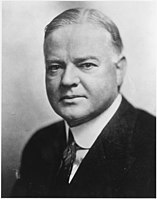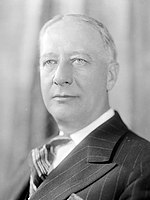| ||||||||||||||||||||||||||
| ||||||||||||||||||||||||||
 County Results
| ||||||||||||||||||||||||||
| ||||||||||||||||||||||||||
| Elections in Kentucky |
|---|
 |
|
|
The 1928 United States presidential election in Kentucky took place on November 6, 1928, as part of the 1928 United States presidential election. Voters chose 13 representatives, or electors to the Electoral College, who voted for president and vice president.
Ever since the Civil War, Kentucky had been shaped politically by divisions created by that war between secessionist, Democratic counties and Unionist, Republican ones,[1] although the state as a whole leaned Democratic throughout this era and the GOP carried the state only in 1896 and 1924.[2]
In 1928, as in all of the upland South, Kentucky's extremely stable Civil War partisan political pattern would become significantly disturbed due to the nomination, after all other prominent Democrats sat the election out due to the prevailing prosperity, of urban, anti-Prohibition Catholic Al Smith.[3] Once Smith was nominated – despite his attempt to dispel fears by nominating "dry" Southern Democrat Joseph T. Robinson as his running mate[4] – extreme fear ensued in the South, which had no experience of the Southern and Eastern European Catholic immigrants who were Smith's local constituency. Southern fundamentalist Protestants believed that Smith would allow papal and priestly leadership in the United States, which Protestantism was a reaction against.[5] In the east of the state where many communities were becoming sundown towns or counties[6] it was believed that Smith was unacceptable also because the Catholic Church officially opposed social and political segregation of the races.[7]
As with the former Confederate states, opposition to Smith in Kentucky was organised by the Protestant churches, led by James Cannon Jr. and Arthur J. Barton.[8] A major state paper, The Western Recorder had been heavily opposing Smith for over a year before the campaign began.[9] When the campaign did begin, Smith's religion was the overwhelming concern,[10] and at the beginning of October it appeared as though Republican nominee Herbert Hoover was likely to carry the state.[11] Although later in October there were thoughts Smith would challenge the GOP nominee,[12] in the end Hoover won the state by a margin of 18.88 percent against Al Smith gaining all thirteen of the state's electors as a result.[13] Traditional Democratic loyalties were maintained best in the Jackson Purchase, where racial issues were of greatest importance and there was opposition from memories of the 1927 Mississippi flood to Hoover's record on flood relief.[14]
Hoover became the first Republican nominee to ever win Kentucky with a majority of the vote or to exceed his national vote share in the state, with Kentucky voting 1.40 points more Republican than the nation at-large. This, in combination with Calvin Coolidge's victory in the state four years prior, also marked the first time that Kentucky voted Republican in consecutive elections. He was the solitary Republican presidential candidate to carry Menifee County until George W. Bush in 2000, and also the first ever Republican victor in the following counties: Anderson, Barren, Boone, Bullitt, Daviess, Grant, Hardin, LaRue, Livingston, Mason, McCracken, McLean, Montgomery, Nicholas, Oldham, Powell, Robertson, Scott, Shelby and Spencer.[15]
This was the last time Kentucky voted Republican until Dwight Eisenhower won the state in his re-election bid in 1956.
- ^ Sullivan, Robert David; 'How the Red and Blue Map Evolved Over the Past Century'; America Magazine in The National Catholic Review; June 29, 2016
- ^ Phillips, Kevin P.; The Emerging Republican Majority, p. 350 ISBN 978-0-691-16324-6
- ^ Warren, Kenneth F.; Encyclopedia of U.S. campaigns, elections, and electoral behavior: A-M, Volume 1, p. 620 ISBN 1412954894
- ^ Nelson, Michael (1991); Historic documents on presidential elections, 1787–1988, p. 296
- ^ Whisenhunt, Donald W.; President Herbert Hoover, p. 69 ISBN 1600214762
- ^ Loewen, James A.; Sundown Towns: A Hidden Dimension of American Racism, pp. 72-74 ISBN 0743294483
- ^ Moore, Edmund A. A Catholic Runs For President (New York, 1956) p. 157
- ^ Watson, Richard L., Jr.; 'Some Recent Interpretations of the Election of 1928'; The High School Journal, May, 1967, Vol. 50, No. 8, "Teaching about Practical Politics" (May, 1967), pp. 428-448
- ^ Miller, Robert Moats; 'A Footnote to the Role of the Protestant Churches in the Election of 1928'; Church History, volume 25, no. 2 (June 1956), pp. 145-159
- ^ Oulahan, Richard V.; 'Many Questions Enter into Kentucky Campaign: But Questions Raised by Smith's Religious Faith Seem to Be Dominant'; The New York Times, September 27, 1928, p. 3
- ^ 'Dixie Hoover Men Predict a Break in the Solid South: State Chairmen Assert Florida, Georgia, Alabama and Kentucky Will Go Republican, Louisiana Held Doubtful'; The New York Times, October 1, 1928, p. 1
- ^ Henderson, William; 'G.O.P. in Kentucky Worried by Smith: Republicans Move to Check Tide Seen Moving Away From Hoover'; The Washington Post, October 21, 1928, p. M4
- ^ "1928 Presidential General Election Results – Kentucky". Dave Leip's Atlas of U.S. Presidential Elections. Retrieved August 13, 2020.
- ^ Heersink, Boris; Peterson, Brenton D. and Jenkins, Jeffery A .; 'Disasters and Elections: Estimating the Net Effect of Damage and Relief in Historical Perspective'; Political Analysis; volume 25, issue 2 (April 2017), pp. 260-268
- ^ Menendez, Albert J.; The Geography of Presidential Elections in the United States, 1868–2004, pp. 206-211 ISBN 0-7864-2217-3
© MMXXIII Rich X Search. We shall prevail. All rights reserved. Rich X Search


